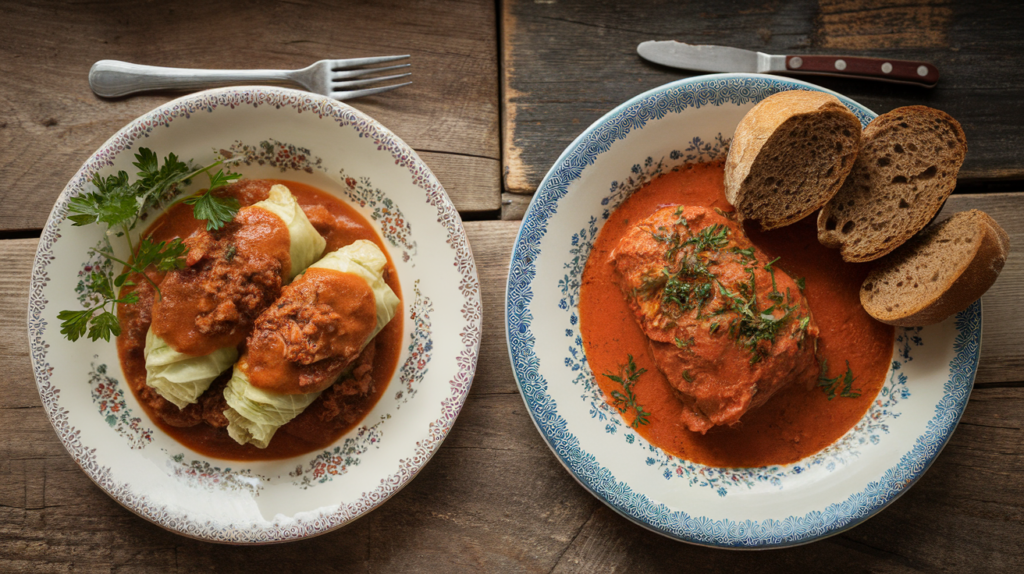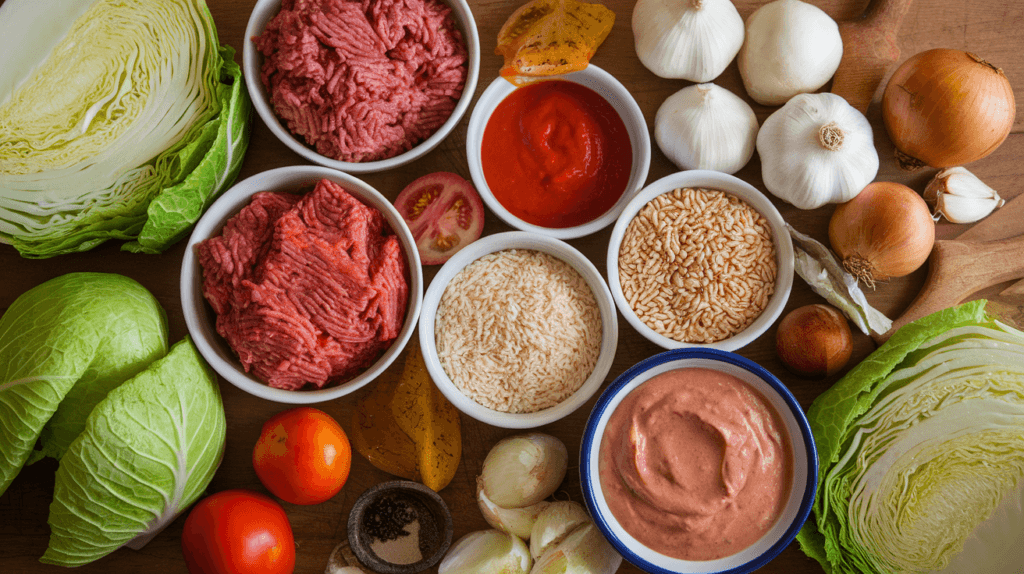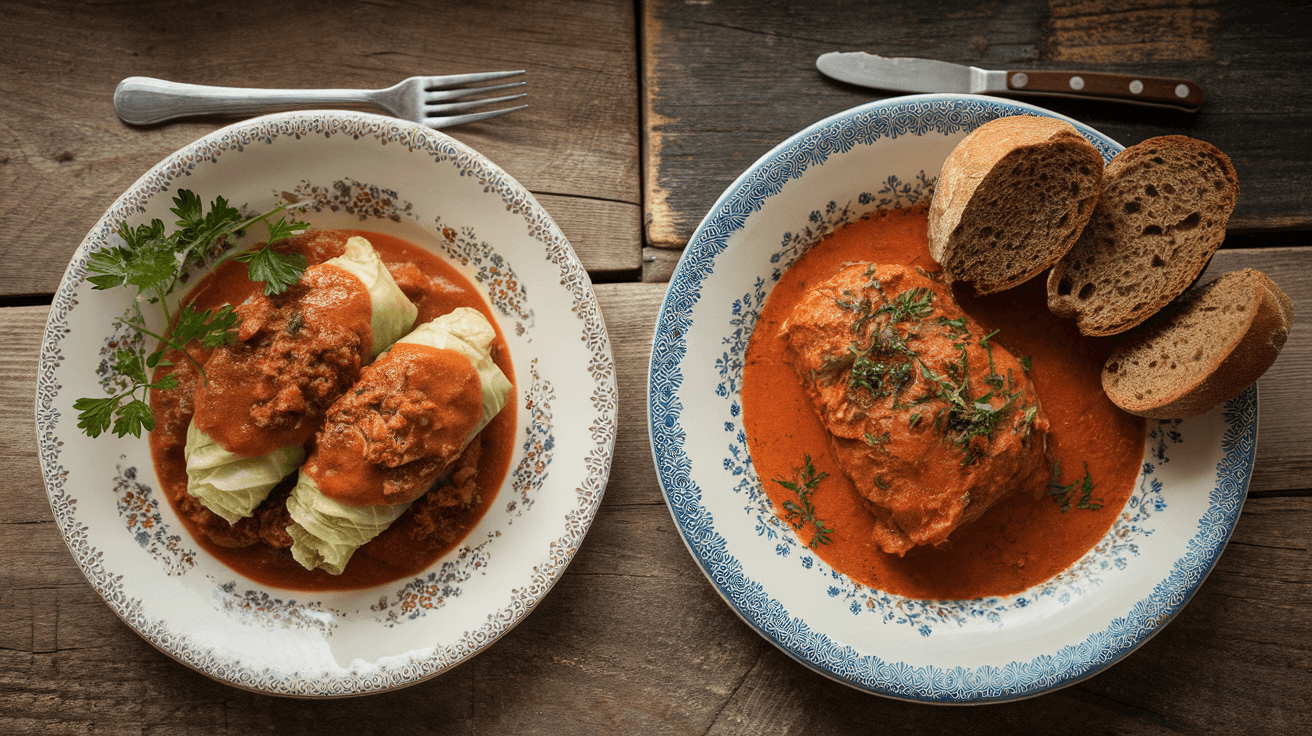What is the Difference Between Halupki and Golumpki?
Halupki and Golumpki are beloved dishes in Eastern European cuisine, often associated with hearty flavors and family gatherings. While the two dishes share similarities, such as being cabbage rolls filled with meat and rice, their differences stem from cultural nuances, preparation methods, and regional interpretations. This article explores the distinctions between Halupki and Golumpki, delving into their origins, ingredients, and culinary variations.
Whether you’re a food enthusiast or simply curious about these traditional meals, understanding the subtle yet meaningful differences between Halupki and Golumpki can deepen your appreciation for Eastern European cuisine. Let’s dive in!

The Origins of Halupki and Golumpki in Eastern Europe
Where Do Halupki and Golumpki Come From?
Halupki and Golumpki both trace their roots to the culinary traditions of Eastern Europe, where hearty and resourceful dishes were a hallmark of daily life. These cabbage rolls emerged as a practical way to create filling meals using affordable, readily available ingredients. However, their names and specific preparations differ depending on the cultural context.
The History of Slovak Halupki
Halupki is a term predominantly used by people of Slovak descent. Slovak immigrants brought this dish to the United States, where it became a cherished part of Slovak-American cuisine. The word “halupki” stems from the Slovak language and represents a variation of stuffed cabbage that is often prepared with sweet and sour tomato-based sauces.
Polish Golumpki: A Culinary Legacy
Golumpki, on the other hand, is a traditional Polish dish, deeply rooted in Poland’s culinary history. The name “golumpki” (sometimes spelled “gołąbki”) translates to “little pigeons” in Polish, a nod to the shape of the rolled cabbage leaves. In Polish households, golumpki is often served during festive occasions, including Christmas and weddings.
Halupki and Golumpki’s Shared Eastern European Heritage
Despite their different names and cultural contexts, Halupki and Golumpki are both examples of the culinary exchange that occurred across Eastern Europe. The concept of cabbage rolls is not unique to Slovakia or Poland; variations can be found in Ukraine, Russia, Hungary, and beyond. Each culture has added its unique twist to the recipe, influenced by local ingredients and traditions.
Immigration and Evolution
As Slovak and Polish immigrants settled in the United States, they adapted their traditional recipes to incorporate locally available ingredients. This adaptation not only preserved the essence of these dishes but also gave rise to variations that are now staples of Eastern European-American cuisine. The evolution of Halupki and Golumpki in immigrant communities highlights their enduring significance and widespread appeal.
Cultural Variations: Halupki vs. Golumpki
Regional Variations Across Eastern Europe
Halupki and Golumpki may appear similar at first glance, but their preparation and presentation reflect distinct cultural traditions. These differences are shaped by the regional flavors, ingredients, and culinary customs of Slovakia and Poland.
How Halupki Reflects Slovak Culinary Traditions
In Slovakia, Halupki is a family staple often associated with celebratory gatherings and comfort food. The Slovak version typically features a sweeter tomato sauce, balanced by a hint of tanginess. The filling is a mix of ground meat, rice, and onions, sometimes enhanced with a touch of garlic or paprika to add depth.
The Slovak approach to Halupki emphasizes balance—neither too spicy nor overly rich. Many families pass down recipes through generations, each adding a personal twist, such as using sauerkraut or layering cabbage leaves in the baking dish for added flavor.
The Role of Golumpki in Polish Cuisine
Golumpki is a centerpiece of Polish feasts, particularly during holidays and festive events. The Polish version is often larger and heartier than its Slovak counterpart, with a filling that leans heavily on savory notes. The tomato sauce for Golumpki is less sweet, sometimes incorporating beef broth or a dollop of sour cream for a creamier texture.
In Poland, golumpki is not just a dish but a symbol of hospitality and tradition. It’s common for Polish families to make large batches of golumpki to share with friends and neighbors, reinforcing a sense of community through food.
Cross-Cultural Influences
The distinctions between Halupki and Golumpki also highlight the culinary influences of neighboring countries. For instance, Hungarian goulash and Ukrainian borscht have influenced the sauces and seasonings used in these dishes. These cross-cultural exchanges have enriched the diversity of flavors found in both Halupki and Golumpki.
Symbolism of Halupki and Golumpki in Slovak and Polish Culture
While both dishes are rooted in practicality and resourcefulness, they hold symbolic value in their respective cultures. Halupki is often seen as a nostalgic reminder of home for Slovak-Americans, while Golumpki represents pride in Polish culinary heritage. These cultural nuances make each dish unique, despite their shared origins.
Halupki and Golumpki: Key Ingredients and Preparation

What Ingredients Make Halupki Unique?
Halupki features a simple yet flavorful combination of ingredients. The main components include:
- Cabbage: Large green cabbage leaves are used to wrap the filling.
- Ground Meat: A mix of ground beef and pork is common, though some variations use turkey or chicken for a lighter option.
- Rice: Cooked white rice serves as a key ingredient for the filling, adding texture and bulk.
- Onions and Garlic: Sautéed onions and minced garlic provide a savory base for the filling.
- Tomato Sauce: Sweet tomato sauce, often mixed with a touch of vinegar or brown sugar, is poured over the rolls.
Essential Ingredients in Polish Golumpki
The ingredients in Golumpki are similar but with subtle differences. Polish recipes often include:
- Cabbage: Green cabbage is preferred, but some regions use savoy cabbage for a softer texture.
- Ground Meat: Traditional golumpki uses ground pork or a mix of pork and beef for a richer flavor.
- Rice or Barley: While rice is common, some Polish recipes incorporate barley for a heartier filling.
- Tomato-Based Sauce: The sauce is less sweet, sometimes made with tomato paste and broth for a more savory profile.
- Eggs and Breadcrumbs: These are added to the filling to bind the ingredients together.
Step-by-Step: How to Prepare Halupki
To prepare Halupki, the cabbage leaves are first softened by boiling or steaming, making them pliable for rolling. The filling is a mixture of ground meat, rice, onions, and seasonings, which is tightly wrapped in the cabbage leaves. These rolls are then arranged in a baking dish, covered with sweet tomato sauce, and baked until tender. The dish is often served with a dollop of sour cream or alongside mashed potatoes.
Step-by-Step Guide to Making Traditional Polish Golumpki
Golumpki preparation follows a similar process, with a few distinctions. The filling is more savory, often featuring a richer mix of seasonings such as marjoram or nutmeg. Once rolled, the cabbage rolls are placed in a pot or baking dish and simmered or baked in a tomato-based sauce. The sauce for Golumpki may include broth or cream to enhance its flavor. This dish is traditionally served as part of a larger meal, accompanied by crusty bread or potatoes.
Cooking Techniques: How Halupki and Golumpki Are Prepared
Both dishes rely on slow cooking methods to allow the flavors to meld and the cabbage to become tender. Some variations call for stovetop simmering, while others favor baking in the oven. Regardless of the method, the result is a comforting and satisfying dish that celebrates the simplicity of Eastern European cuisine.
Halupki vs. Golumpki: Key Differences in Ingredients and Preparation
The primary differences lie in the sweetness of the sauce and the seasoning of the filling. Halupki leans towards a sweeter profile, while Golumpki emphasizes savory and earthy flavors. Additionally, the use of barley in some Golumpki recipes sets it apart from the rice-based filling in Halupki.
Taste and Flavor Differences Between Halupki and Golumpki
The Flavor of Halupki
Halupki is known for its comforting, slightly sweet flavor profile. The sweetness comes from the tomato sauce, which is often enhanced with brown sugar or a splash of vinegar to create a balanced sweet-and-sour taste. The filling, made with a mix of ground meat and rice, offers a mild yet satisfying flavor, complemented by the natural savoriness of sautéed onions and garlic.
Slovak recipes for Halupki sometimes incorporate paprika or caraway seeds, giving the dish a subtle spice and warmth. The cabbage wrapping absorbs the flavors of the sauce during cooking, resulting in a tender, flavorful roll that melts in your mouth.
The Flavor of Golumpki
Golumpki, in contrast, has a heartier and more savory flavor profile. The tomato sauce used in Golumpki is less sweet, often seasoned with broth or sour cream for a tangy, creamy taste. This creates a more robust sauce that pairs well with the rich filling.
The filling itself has a pronounced meatiness, thanks to the traditional use of ground pork or a pork-beef blend. Polish recipes may also include marjoram or nutmeg, adding earthy and aromatic notes. The resulting flavor is deeply savory, with a slightly tangy kick from the tomato-based sauce.
Texture Differences
Another key distinction lies in texture. Halupki tends to be softer and more cohesive due to its sweeter sauce and simpler seasoning. The rice filling gives it a lighter texture compared to Golumpki, which often uses barley or additional binding agents like breadcrumbs for a denser filling.
The cabbage leaves in both dishes are tender, but Golumpki rolls are often larger and firmer, reflecting their heartier filling and longer cooking times.
How They Compare in Taste
The taste of Halupki is often described as gentle and comforting, ideal for those who enjoy sweet and mild flavors. Golumpki, on the other hand, appeals to those who prefer bold, savory flavors with a touch of tanginess. These differences make each dish unique, catering to a range of palates.
Pairing Flavors
Halupki pairs well with side dishes that enhance its sweet profile, such as buttery mashed potatoes or roasted root vegetables. Meanwhile, Golumpki’s robust flavors are complemented by tangy accompaniments like pickled cucumbers or rye bread. Both dishes can be elevated with a dollop of sour cream, which adds creaminess and balance to their respective flavor profiles.
Key Takeaways
In summary, Halupki delivers a sweeter, milder experience with a focus on balanced flavors, while Golumpki offers a savory, tangy taste with a heartier texture. Both dishes share a comforting essence that speaks to their Eastern European heritage, making them beloved staples of family meals and celebrations.
How Halupki and Golumpki Are Served

How Halupki is Served
Halupki is traditionally served warm, often as a main course. The cabbage rolls are plated with extra sweet tomato sauce ladled on top, adding moisture and flavor. Common side dishes include creamy mashed potatoes, buttered egg noodles, or simple steamed vegetables. Sour cream is frequently added as a garnish to balance the sweetness of the sauce.
How Golumpki is Served
Golumpki is similarly served hot and often accompanied by hearty side dishes like boiled potatoes, rye bread, or pickled vegetables. In Poland, it is not unusual to serve Golumpki with a bowl of clear soup, such as borscht, to start the meal. The tangy sauce pairs perfectly with sour cream, adding richness and depth to the dish.
Perfect Pairings
Both Halupki and Golumpki benefit from simple accompaniments that allow their flavors to shine. Light salads, roasted vegetables, or a glass of chilled white wine can elevate the meal while keeping the focus on the cabbage rolls themselves.
FAQs
1. Are Halupki and Golumpki the same dish?
While they are similar in concept, Halupki and Golumpki differ in their cultural origins, flavor profiles, and slight variations in ingredients. Halupki is Slovak, featuring a sweeter tomato sauce, while Golumpki is Polish and emphasizes savory, tangy flavors.
2. Can I substitute one for the other in recipes?
Yes, you can substitute one for the other, but keep in mind the differences in sauce sweetness and seasoning. Adjust the recipe to match your flavor preferences.
3. What is the main difference in ingredients?
The main difference lies in the sauce and filling. Halupki uses a sweeter tomato sauce, while Golumpki includes a more savory, tangy sauce. Additionally, Golumpki sometimes incorporates barley or cream in the filling.
4. Are there vegetarian versions of these dishes?
Yes! Vegetarian versions use ingredients like lentils, mushrooms, or quinoa in place of meat. The tomato sauce can remain the same, though some recipes add more vegetables for extra flavor.
5. What is the best cabbage to use?
Green cabbage is the most common choice for both dishes due to its sturdy leaves. Savoy cabbage is also a great alternative for a softer texture and milder flavor.
6. Can these dishes be made ahead of time?
Absolutely! Both Halupki and Golumpki are ideal for making ahead. Prepare and assemble the rolls, then refrigerate or freeze them. Bake or reheat with the sauce when ready to serve for a convenient, delicious meal.
Conclusion
Halupki and Golumpki are two delightful examples of Eastern European culinary traditions, showcasing the ingenuity and resourcefulness of their respective cultures. Despite their similarities, the differences in their flavor profiles, ingredients, and cultural significance make each dish unique.
Whether you prefer the sweet, comforting taste of Halupki or the savory, hearty flavor of Golumpki, both dishes offer a taste of heritage and family traditions. By exploring these cabbage rolls, you’re not just enjoying a meal—you’re savoring a piece of history.
Next time you’re craving a warm, hearty dish, try making Halupki or Golumpki and experience the rich flavors of Eastern Europe firsthand!

